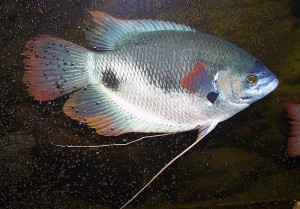Giant Red Tail Gourami (Osphronemus laticlavius) are also known to tropical fish keeping enthusiasts as Giant Red Finned Gourami, Red Flag Giant Gourami, Giant Red Fin Goramy, and Red Tail Gourami and are found in Indonesia and Malaysia.
The four recognized species in the Osphronemus genus that are commonly referred to as giant gouramis are listed below along with their maximum lengths:
- Giant Gourami (Osphronemus gouramy) 28″ max
- Giant Red Tail Gourami (Osphronemus laticlavius) 20″ max
- Elephant Ear Gourami (Osphronemus exodon) 24″ max
- Kaloi Sarawak, Giant Gourami (Osphronemus septemfasciatus) 20″ max
Giant Red Tail Gourami are rare in the aquarium hobby and have only been known to science since the early 1990s.
Like Giant Gourami, Osphronemus laticlavius are found in the heavily vegetated stagnant waters of swamps, marshlands, and sluggish moving canals. They are also found in slow moving rivers, lakes, and flooded forests during the rainy seasons and like other gourami, they posses a special labyrinth organ that enables them to survive in oxygen depleted waters.
Giant Red Tail Gourami have a laterally compressed, deep, oval shaped body, and a blunt head. Juveniles have a steely blue gray to black body color that develops beautiful blue green highlights as the fish mature. Adults have a blue green to almost black body color and fins that are trimmed in bright red, with filamentous extensions and a “nuchal” hump on their forehead. The females usually have thicker lips.
Giant Red Tail Gourami make great pets. Like Giant Gourami, they are able to recognize their owners and over time can develop real personalities.
Giant Red Tail Gourami are generally peaceful, but there can be exceptions to this rule, especially when they are housed in a small aquarium. In rare instances a large male will become territorial and attack other fish, but in a properly sized tank, they are generally a good community fish with other larger species like knife fish, large catfish and loricariid. When juveniles have been raised together with smaller barbs, tetras, danios, etc. they don’t consider their tankmates dinner and usually ignore them. However, as they grow into adults, they “own” the tank and any new additions, regardless of size, will likely be killed.
Giant Red Tail Gourami should be housed in at least a 180 gallon or larger aquarium with a dark gravel or coarse sand substrate, some large rocks
and pieces of driftwood for them to hide among, some floating plants
, and plenty of free swimming space. This species is a voracious herbivore so it is not advisable to plant slow growing aquatic vegetation in their tank. Despite the fact that they can breathe atmospheric air and can tolerate a variety of water parameters, they need a good filtration system, some water movement, and clean water to thrive. The use of a canister filter
and weekly 20-30% water changes are highly recommended.
In their natural habitat, male Giant Red Tail Gourami build ball shaped bubble nests approximately 16″ W. by 12″ D. out of bits of vegetable matter from 6″ to10″ below the surface of the water, and anchor it to the reeds or to subsurface grass. The male takes about a week to 10 days to construct the nest (usually during April and May) at which time the spawning takes place.
Between 1,500 and 3,000 eggs are fertilized and released into the nest. Both the eggs and the fry (when hatched) are lighter than water and will float to the top of the bubble nest. The male will gather them into his mouth and place them into the nest where they are guarded until they hatch. In approximately 40 hours the eggs hatch, and 15 days later the fry will be free swimming.
Breeding Giant Red Tail Gourami in an aquarium environment has not yet been reported, however, they probably breed in a similar fashion to
their cousin the Giant Gourami (Osphronemus goramy). The fish are sexually mature at about 6 months of age or at a size of 4″ to 5″, however they still require a large breeding tank. The male builds a large bubble nest with grasses, roots, small twigs, and floating plants and anchors it below the surface. The actual spawning occurs in the vicinity of the nest where the eggs are placed and tended to by the male until they hatch. The male then chases away the female and in 24 to 36 hours the eggs hatch. In 3 to 5 days the fry are free swimming and able to eat on their own however, the male will continue to guard the fry for several weeks unless removed from the tank. The fry can be fed crushed omnivore flake food
or newly hatched baby brine shrimp.
Giant Red Tail Gourami are opportunistic feeders and in their natural habitat will consume copious amounts of vegetable and animal matter. Their natural diet consists of aquatic weedy vegetation, small fish, frogs, earthworms, crustaceans, and sometimes even carrion.
In an aquarium environment, they should be fed a balanced diet heavy on vegetable matter.
Besides omnivore flakes and pellets, they will eagerly accept live, frozen or freeze dried brine shrimp, worms, fish, bloodworms, algae wafers, lettuce, boiled potatoes, peas, cooked foods, etc. Beef heart and meat from mammals should be only fed sparingly. They are not picky eaters and will eat almost any aquarium food if trained to do so as juveniles. Feed them once or twice daily.
Although the demand from tropical fish keeping enthusiasts for this species is high and the fish are quite pricey, Giant Red Tail Gourami are only occasionally available for purchase online.
Minimum Tank Size: 180 gallons
Care Level: Moderate
Temperament: Relatively Peaceful
Aquarium Hardiness: Very Hardy
Water Conditions: 68-86°F, 5-25°H, pH 6.5-8.0
Max Size: 20″
Color Form: Blue, Gray, Red
Diet: Omnivore/Primarily Herbivore
Compatibility: Large Community Tanks
Origin: Indonesia, Malaysia
Family: Osphronemidae
Lifespan: 20+ years
Aquarist Experience Level: Intermediate





